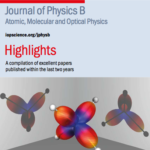Our article on an adjustable Ioffe Pritchard trap has just been voted to to be one of the most important articles of the year 2012 of the Journal of Physics B.
!
Cretan Matter Waves Group

Our article on an adjustable Ioffe Pritchard trap has just been voted to to be one of the most important articles of the year 2012 of the Journal of Physics B.
!

Journal of Physics B 45 235301 (2012)
V. Bolpasi, J. Grucker, M. J. Morrissey, and W. von Klitzing
http://dx.doi.org/10.1088/0953-4075/45/23/235301 or http://doi.org/10.1088/0953-4075/45/23/235301
 Abstract: The Ioffe–Pritchard trap is the workhorse of modern cold atom physics. Here, we present a novel Ioffe–Pritchard trap coil configuration based purely on circular coils. By eliminating the traditional Ioffe bars one can increase the gradient and thus the radial trapping frequency by almost a factor 2. We also present a method to achieve minimal coupling between the gradient, curvature and offset fields of the trap, thus facilitating the dynamic control of the trapping frequencies and aspect ratio.
Abstract: The Ioffe–Pritchard trap is the workhorse of modern cold atom physics. Here, we present a novel Ioffe–Pritchard trap coil configuration based purely on circular coils. By eliminating the traditional Ioffe bars one can increase the gradient and thus the radial trapping frequency by almost a factor 2. We also present a method to achieve minimal coupling between the gradient, curvature and offset fields of the trap, thus facilitating the dynamic control of the trapping frequencies and aspect ratio.
This paper was selected by the editors as one of the highlights of 2012 of Journal of Optics B.

Central European Journal of Physics 10 1054–1058 (2012)
G. O. Konstantinidis, M. Pappa, G. Wikstroem, P. C. Condylis, D. Sahagun, M. Baker, O. Morizot, and W. von Klitzing
http://dx.doi.org/10.2478/s11534-012-0108-x
Abstract: Cold atom experiments often use images of the atom clouds as their exclusive source of experimental in- formation. The most commonly used technique is absorption imaging, which provides accurate information about the shapes of the atom clouds, but requires care when seeking the absolute atom number for small atom samples. In this paper, we present an independent, absolute calibration of the atom numbers. We di- rectly compare the atom number detected using dark-ground imaging to the one observed by fluorescence imaging of the same atoms in a magneto-optical trap. We normalise the signal using single-atom resolved fluorescence imaging. In order to be able to image the absorption of the very low atom numbers involved, we use diffractive dark-ground imaging as a novel, ultra-sensitive method of in situ imaging for untrapped atom clouds down to only 100 atoms. We demonstrate that the Doppler shift due to the acceleration of the atoms by the probe beam has to be taken into account when measuring the atom-number.

Ben Sherlock joins us from Oxford University (Chris Foot’s group) and before this M.Sci. at Hatfield College, University of Durham. Ben is one of the pioneers of Time-Averaged-Adiabatic Potentials with the first demonstration of the TAAP dumbbell and TAAP ring.

06/2010 – today Professor at the Department of Materials Science and Technology, University of Crete
Dimitris is involved in everything optical in the BEC group.

Great news!!! we have our first BEC…
You must be logged in to post a comment.